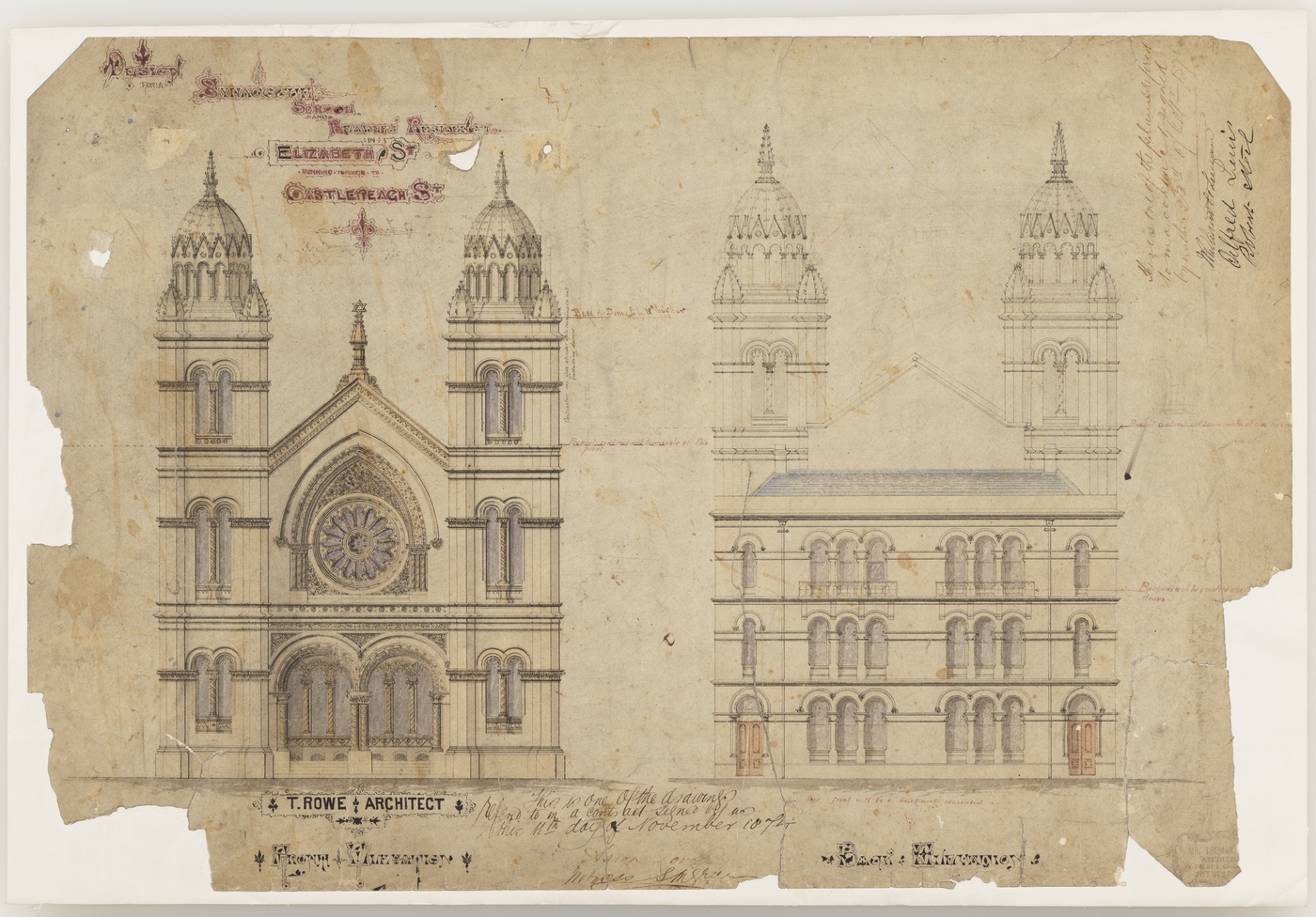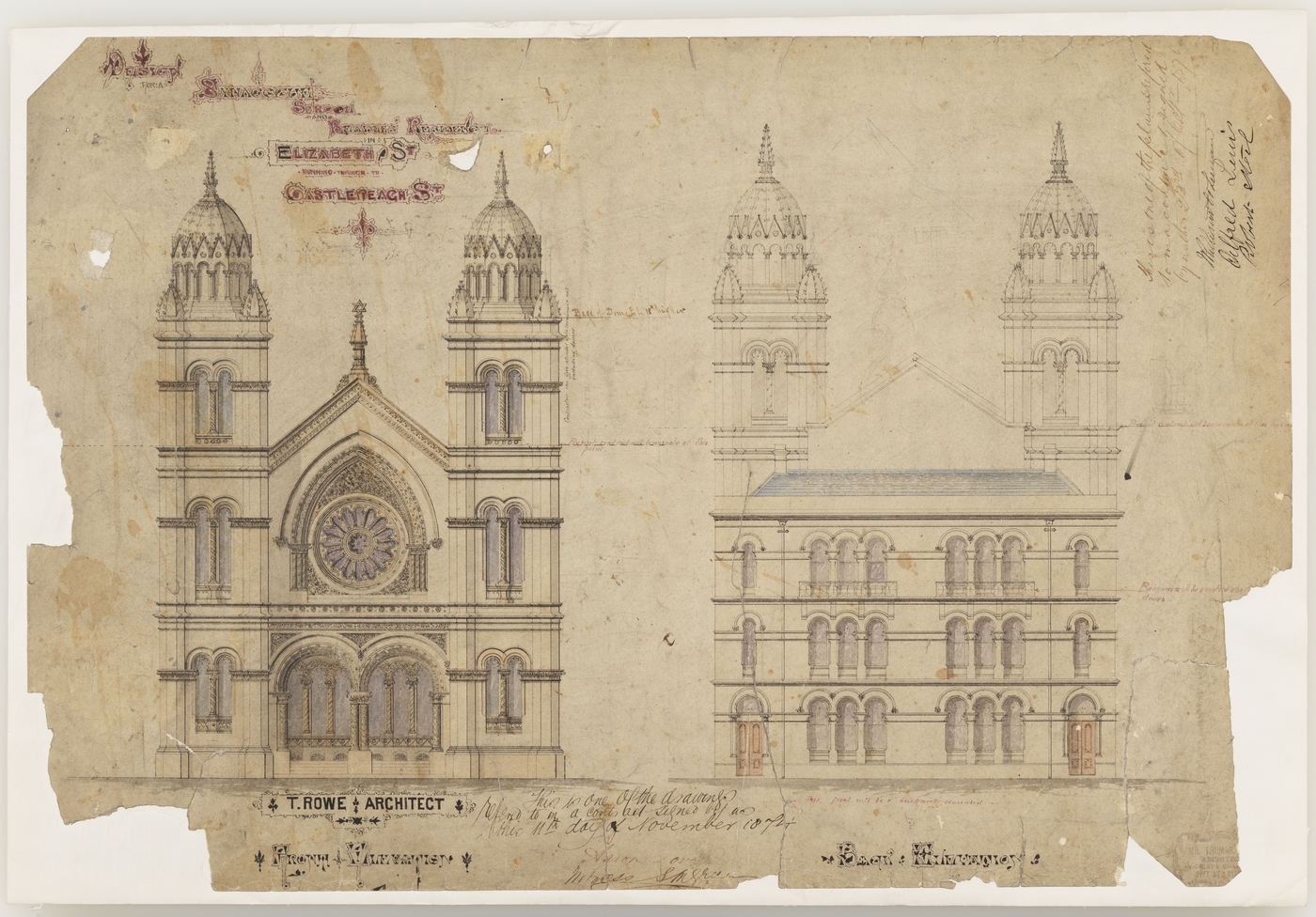The Great Synagogue
In 1859, debate over the circumcision of the son of a non-Jewish mother caused a split within Sydney’s Jewish community. Many of the founders of the Sydney Synagogue broke away and established the Sydney New Synagogue in a former Baptist chapel on Macquarie Street.
The Sydney Synagogue continued at its York Street location, until the building could no longer house the growing Hebrew congregation. By that time, the Sydney New Synagogue was struggling financially. Both synagogues soon understood the futility of carrying on as separate congregations.
The Jewish Synagogue and Schools Act of 1872 gave the Sydney Synagogue permission to sell land it had previously been granted. This included land adjoining the York Street premises and a portion on Church Hill that had been designated for use as a school. The sales of these properties - and proceeds from the sale of properties bequeathed by congregation members Simon Lear and M. L. Jonas - aided in the building of new, enlarged premises that would become known as the Great Synagogue.
Thomas Rowe, a notable architect of Victorian-era Sydney, designed the iconic Great Synagogue building which was situated on an impressive block fronting both Castlereagh Street and Elizabeth Street, opposite Hyde Park.
On 26 January 1875, Sydney’s Jewish community gathered to celebrate the laying of the foundation stone by the Hon. (later Sir) Saul Samuel, then postmaster-general and later a president of the Great Synagogue, who gave a stirring speech and buried a time capsule.
One of the greatest contributions to the Great Synagogue's building fund was provided by the Hebrew Ladies’ Bazaar. In December 1875, the women of Sydney’s Jewish community staged a very successful 'sale of work or 'fancy fair' at which great quantities of handicrafts and gifts were sold to raise funds for the construction of the new synagogue.
Jews tend to live in close proximity to synagogues. As all forms of work are prohibited on Saturday, the Jewish Sabbath, most observant Jews see driving as a form of work and tend to live within walking distance of their local synagogue. Changes to Sydney’s demography throughout the 20th century saw Jewish communities established across Sydney’s spreading suburbs. Yet, despite such changes, the Great Synagogue remains a centre of Jewish religious life in Sydney, and a leading force among the synagogues of New South Wales to this day.





The Great Synagogue Foundation Stone
On 26 January 1875, Sydney’s Jewish community gathered together to celebrate the laying of the foundation stone for the central arches of the Great Synagogue. Construction of an iconic Sydney building was underway. The Hon. (later Sir) Saul Samuel, then postmaster-general and later a president of the Great Synagogue, gave a stirring speech as he laid the foundation stone and buried a time capsule. The sense of occasion and excitement were captured in Samuel’s speech, reproduced below from Sydney newspaper The Empire.
The souvenir booklet below sets out the formalities of the ceremony. The original booklet, with several passages in Hebrew, was published to read right-to-left. We have reproduced it here so that it reads left-to-right.






The Hon. Saul Samuel's speech, as published in The Empire, 27 January 1875:
"I feel greatly honoured in having been selected to lay the foundation-stone of this edifice, now in course of construction for the worship of the great God of Israel. It is a distinction of which I shall be ever proud, and my memory will greatly treasure the kindly feelings which prompted you to invite me to take so prominent a part in this important ceremony today. The commencement of the building of a place of worship in a large city, under ordinary circumstances, would not be considered a matter of unusual moment; but to the small community of Jews in this colony it is an object of deep interest and importance. It is now over thirty years since the synagogue in York-street was completed and consecrated to public worship. At that time our people were but few, but they have since so increased in numbers as to render it apparent that the present place of worship is not large enough for the congregation. It was therefore resolved by a number of gentlemen that an effort should be made to raise funds for the erection of a new synagogue, which should be worthy of us as a religious body, an ornament to the city in which we live, and a temple in which we might with feelings of true devotion offer up our prayers to the Great Giver of all things. A public meeting was held, at which I had the honour to preside, a committee was formed, and other arrangements were made for effecting this object. Large and liberal contributions have enabled us to commence the great work; and to complete which, I pray that God may grant us His aid, for "unless the Lord build the house, they labour in vain who build it". I feel, indeed, that some one more deserving and some one who has paid more regard to the performance of his religious duties than myself, might well have been chosen for the position I proudly occupy today. But whatever may be my deficiencies, in this regard, there is no firmer believer in our holy faith than myself; nor is there any one more anxious for the improvement and elevation of the Jewish people; and this, I trust, has been evidenced by my past career. (Cheers.) That the edifice we are about to raise for the worship of the Lord God of our fathers may be a beacon of light and a serene haven to the sons of Israel is my devout wish. I must tell you that, although the donations have been most liberal, they are insufficient to complete the work before us. I therefore appeal to you for further aid, trusting that before we separate there will be such a hearty and generous response as will suffice to accomplish what we all generously desire — the early consecration of this building for public worship. The cost, it is estimated, will be nearly £20,000 — a sum, I believe, that will be admitted to be very large to be raised by a community not numbering more than 3000 in the whole of New South Wales, and not one-third of that number resident in the city of Sydney. Small, however, as are our numbers, I feel confident that you will finish what you have so nobly begun, and that the work of this splendid structure will proceed uninterruptedly until its final completion. Let us pray that the day may soon come when a happy and prosperous congregation shall assemble in this place. (Applause.) Scattered as our race has been in every quarter of the globe, no matter how small their number, they have always taken the first opportunity to unite in the worship of the Almighty. I hope that the same feeling may prevail here; and that the completion of this place of worship may be the means of uniting us as one family, burying in oblivion any differences of the past." (Applause.)
Detailed description of the Synagogue building, as published in The Empire, 27 January 1875:
'The new Jewish Synagogue, school, and beadle's residence are already in forward condition, the basement contract having been finished some time since, and tenders have been again received for the main work of erecting the building. The site occupies a frontage to both Elizabeth and Castlereagh streets, running from one to the other, the measured area being 64 feet by a depth of 140 feet, the whole of which will be covered in, with the exception of a small space between the synagogue and school, forming yard.'
'The style of Elizabeth-street principal front is Byzantine, freely treated with the introduction of Gothic forms. The material to be used in this front is the best freestone, the elevation of which will present an imposing appearance. This frontage will be divided into three features, the main and central one being flanked by two square towers, with octogonal turrets springing from the angles, and therewith towers being terminated by domed tabernacles finishing with richly carved finials, with crockets, &c.; the centre feature in the gable terminating the nave or the building eastward. The principal entrance to the synagogue will be under two arches (to a spacious porch), supported by beautifully carved columns with enriched polished caps. The arches will be moulded and relieved by carved work; on either side of the porch are entrance doors under towers leading to synagogue, and likewise doors to staircases of gallery for ladies. At the back of porch there are seven rich windows; and over this magnificent entrance is to be a large wheel window of beautiful design, richly carved and moulded, recessed under a magnificent moulded and carved arch supported on triplet columns, which also will be enriched and carved. The two square towers, with the octagonal turrets on the angles, finishing with domed roofs of stone. These flank the central feature, causing a beautiful contrast, at the same time in keeping with front, but in a simpler style. The interior, when decorated in the manner suggested by the architect, will form one of the fine features of the structure.'
'The synagogue is to be divided into a centre or nave, and lateral aisles of six bays in length. On the ground floor the seats are to be arranged to face west and south, leaving a centre space unoccupied by sittings throughout the whole length of space up to seats. At the western end of the nave, and under a lofty, moulded, and enriched arch, supported on groups of columns, is to be placed the ark; the whole to be richly decorated, forming a magnificent internal effect. A flight of steps will lead up to the floor, upon which is to be placed the ark, which is to be of a beautiful kind. The eastern end of synagogue gallery floor will have one large moulded arch, with a magnificently ornamented screen, which divides the boardroom from gallery. The columns of nave supporting clerestory are to be 27 feet 3 inches high, surmounted by cusped arches with pointed labels, the spandrils of which will be enriched with foliage, carrying a clerestory of 36 arch windows. The ceilings will he groined, springing from ornamental columns, and moulded, panelled &c., and ultimately decorated in colours. The windows throughout to be glazed, with ornamental glass. The whole of the building will be lighted with gas, every convenience being provided as far as retiring rooms, &c. The gallery portion, being set apart for the accommodation of female worshippers, will be beautifully and elegantly treated, giving the interior a grand appearance.'
'The Castlereagh-street front which comprises the school and beadle's residence. The lower floor will be composed of a room 43 feet 6 inches by 21 feet, and 15 feet high; the light will be supplied by twelve windows. On the first floor the infant school, 21 by 21 feet 9 inches, is to be placed. On the other side of which accommodation has been reserved for the beadle. The second floor also will be used for the beadle's residence. A spacious playground, under the synagogue, has also been provided for the children. The elevation of this front is neat but effective, being formed of triplet light windows, with labels supported by bosses with moulded strings; the whole to be crowned by neat and well designed cornice. It is supposed that the synagogue will seat 1000 adults. The building was designed and is being carried out under the superintendence of the well-known architect, Mr. Thomas Rowe; the contractor for mason work being Mr. Aaron Loveridge.'
Sponsors
Australian Jewish community and culture is made possible through a partnership with the Australia-Israel Chamber of Commerce.














